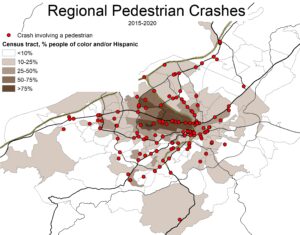This article appeared in the Roanoke Times on June 28, 2021
The pandemic brought less driving – but more, and worse, crashes
During 2020, the year of the COVID-19 pandemic, driving dropped and traffic fatalities climbed – particularly pedestrian traffic fatalities. In Virginia, driving decreased 16.6% yet traffic fatalities increased 2.4% to 847 people killed in traffic, similar to national trends.
This is unexpected. In the past, the crash-rate rises when people drive more. When driving plummeted in the 2008 recession, traffic fatalities dropped too. As the economy rebounded, Americans drove more and traffic fatalities climbed. In 2017, traffic fatalities in the U.S. hit a high at 37,473 and pedestrian fatalities reached 5,977. In the ten years before the pandemic, Virginia’s roadway deaths have grown from less than 700 in some years to over 850 in others.
The difference this year is that driving decreased but traffic fatalities didn’t. They increased.
Pedestrians are disproportionately represented in traffic fatalities and injuries
Traffic safety professionals say that pedestrians are “overrepresented” in traffic fatalities and injuries. meaning people walking are far more likely to get hurt or killed in a crash than we would expect, considering how many trips are made by walking. Two percent of travelers in Roanoke are pedestrians, but almost half of the people killed (7 of 16) and one-quarter of the people injured (70 of 297) in 2020 were walking and the outlook for pedestrians has gotten worse in recent years.
In 2020, the number of pedestrian fatalities in Virginia were about the same (123) as in 2019 (126), but when you consider that less driving happened, the rate of pedestrian traffic deaths actually increased 17%. The pandemic year was deadly for pedestrians in the Roanoke Valley. More pedestrians were injured (70) and killed (7) in 2020 than in any year since 2013.
The burden is not shared equally. Black and brown pedestrians are at greater risk of being injured or killed in a traffic crash than other people. In Roanoke, most pedestrian crashes occur in neighborhoods where more than ten percent of the population are minority race or ethnicity.
What’s going on?
There are many contributing factors, but one key suspect stands out: an increase in speeding during the pandemic.
Speeding is deadly. In a collision with a car traveling 20 mph, 95% of pedestrians survive, but in a collision with a car traveling 40 mph, 85% of pedestrians do not survive. And although traffic congestion feels dangerous, congestion actually slows down traffic speeds. Even if there are more crashes overall because of traffic congestion, they are fender benders with no injuries. Last year, with fewer people driving, there was less traffic congestion and therefore, faster (and deadlier) traffic speeds.
The Roanoke Valley saw a 178% increase in speeding-related fatalities. The City of Roanoke and Roanoke County both had double or more the number of speeding related-fatalities in 2020 compared to 2019.
What are we doing about it?
The City of Roanoke launched a pedestrian safety campaign in 2020, “Every Corner is a Crosswalk”, and this year is focusing on traffic speed awareness with the “No Need to Speed” campaign. Brandon Avenue, which was due for repaving, is getting a safety make-over which involved trying out temporary lane closures and a survey with hundreds of responses before the final design. In 2020 alone, the City invested over 1 million dollar in pedestrian safety improvements focused on intersection upgrades such as pedestrian push buttons, audible signals and more street lighting in the City Downtown and other pedestrian corridors like Williamson Road and 9th Street SE.
The Roanoke Valley Transportation Planning Organization developed a Pedestrian Vision Plan in 2015 with an interactive map. The Virginia Department of Transportation worked with the Roanoke Valley-Alleghany Regional Commission on the Roanoke Valley Regional Transportation Safety Study to understand regional issues.
The Virginia Department of Transportation has two initiatives that should make a difference. Its Strategic Highway Safety Plan, Arrive Alive, is similar to a Vision Zero goal of zero traffic fatalities as the guiding principle of its transportation planning. Its Pedestrian Safety Action Plan, created just a couple years ago and has already been updated, comes with funding to guide cities and counties to invest more in pedestrian safety. In the state legislature, a handsfree ban and removing a barrier for localities to lower speed limits may help.
Having local, regional, and state plans and initiatives in place is important to take advantage of federal funding that will have a strong impact in reversing the trend of rising traffic fatalities.

